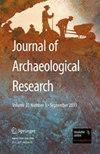"缺乏城镇的大象":从考古学角度看西非城市及其腹地
IF 4.1
1区 历史学
Q1 ANTHROPOLOGY
引用次数: 0
摘要
长期以来,撒哈拉以南非洲一直被认为缺乏自生城市发展的潜力,近东和欧洲的接触为非洲大陆出现前殖民城市提供了现成的解释。在过去的几十年里,非洲城市考古工作的步伐加快,考古学家越来越多地采用城市功能模式,即根据更广阔的腹地而非特定特征来定义城市。因此,在非洲大陆的各个角落都发现了根深蒂固的城市传统。尽管非洲各地的城市传统源远流长,但远距离力量显然对城市发展轨迹产生了广泛影响,而功能模型的支持者尚未解释远距离力量在城市化进程中的具体作用。本综述将具体探讨多方力量如何塑造西非的城市发展轨迹。我研究了地方政治企业家如何利用地方、地区间和全球力量提供的机遇,从而在西非形成了从贸易转口港到地区首府等一系列不同的城市传统。我自始至终都在强调地方机构如何与多财政社会和经济力量相衔接,改变地区一体化、经济专业化和社会差异的性质,这些都是城市生活的决定性特质。本文章由计算机程序翻译,如有差异,请以英文原文为准。
“Elephants for Want of Towns”: Archaeological Perspectives on West African Cities and Their Hinterlands
Sub-Saharan Africa has long been seen as lacking the potential for autochthonous urban development, and Near Eastern and European contact provided ready explanations for the emergence of precolonial cities across the continent. In the past few decades, the pace of archaeological work on African cities has accelerated, and archaeologists have increasingly deployed a functional model of the city, in which cities are defined in relation to broader hinterlands rather than particular traits. As a result, deeply rooted urban traditions have been identified in all corners of the continent. Despite the antiquity of urban traditions across Africa, however, long-distance forces clearly had wide-reaching impacts on urban developmental trajectories, and proponents of the functional model have yet to explain the specific role of long-distance forces in the process of urbanization. This review examines how multiscalar forces shaped urban trajectories in West Africa, specifically. I examine how local political entrepreneurs took advantage of the opportunities provided by local, interregional, and global forces, resulting in a heterogeneous set of urban traditions across West Africa, ranging from trading entrepôts to regional capitals. Throughout I emphasize how local agency articulated with multiscalar social and economic forces, transforming the nature of regional integration, economic specialization, and the materialization of social difference, defining qualities of urban life.
求助全文
通过发布文献求助,成功后即可免费获取论文全文。
去求助
来源期刊

Journal of Archaeological Research
Multiple-
CiteScore
10.20
自引率
7.90%
发文量
9
期刊介绍:
Journal of Archaeological Research publishes the most recent international research summaries on a broad range of topics and geographical areas. The articles are intended to present the current state-of-the-discipline in regard to a particular geographic area or specific research topic or theme. This authoritative review journal improves access to the growing body of information and literature through the publication of original critical articles, each in a 25-40 page format.2-Year Impact Factor: 4.056 (2017) 5-Year Impact Factor: 4.512 (2017)2 out of 85 on the Anthropology listIncluded in the European Reference Index for the Humanities (ERIH) PLUS The European Reference Index for the Humanities and the Social Sciences (ERIH PLUS) was created and developed by European researchers under the coordination of the Standing Committee for the Humanities (SCH) of the European Science Foundation (ESF). https://dbh.nsd.uib.no/publiseringskanaler/erihplus/about/indexSCImago Journal and Country Rank (SJR) 2018: 1.7102 out of 263 on the Archeology (Arts and Humanities) list3 out of 254 on the Archeology list2 out of 131 on the General Arts and Humanities listSJR is a measure of the journal’s relative impact in its field, based on its number of citations and number of articles per publication year.Source Normalised Impact per Paper (SNIP) 2018: 2.112The SNIP measures contextual citation impact by weighting citations based on the total number of citations in a subject field. The impact of a single citation is given higher value in subject areas where citations are less likely, and vice versa.CiteScore 2018: 3.86Rated ''A'' in the Australian Research Council Humanities and Creative Arts Journal List. For more information, visit: http://www.arc.gov.au/era/journal_list.htm
SCImago Journal and Country Rank (SJR) 2011 1.227 Archeology 1 out of 96 Archeology (Arts and Humanities) 1 out of 59 Arts and Humanities (miscellaneous) 1 out of 243
 求助内容:
求助内容: 应助结果提醒方式:
应助结果提醒方式:


